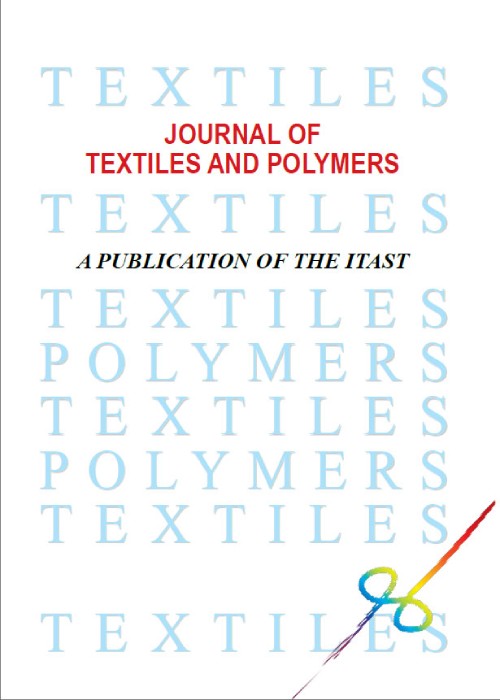فهرست مطالب
Journal of Textiles and Polymers
Volume:10 Issue: 3, Summer 2022
- تاریخ انتشار: 1401/06/10
- تعداد عناوین: 5
-
-
Pages 3-12Currently, replacement of hazardous chemicaltreatments with environmentally-friendly alternativescoupled with assimilation of different processes in onestep in order to save water and energy and prevent theproduction of waste is one of the priorities of industriesthat seek sustainable development and cleaner production.Conventional demineralization of cotton fabric is mostlycarried out using mineral acids which are corrosive, toxic,and above all, could cause fabric damage. In addition,demineralization as a separate step requires a high rate ofwater and energy consumption. This study examines thepossibility of simultaneous desizing and demineralizationusing an acidic and nonvolatile ionic liquid. Evaluation ofdifferent experimental conditions revealed that under propercondition via morpholinium hydrogen sulfate, simultaneousdemineralization and starch desizing of the cellulosicsubstrate could be carried out with a significant decrease inthe concentration of cationic metal ions like Fe2+, Cu2+, Mg2+,Ca2+, and Zn2+ while the quality of desizing is at the samerange as conventional enzymatic hydrolysis (Tegewa: 8-9).This new method did not show any negative effects on thesubstrate tensile properties.Keywords: Demineralization, desizing, cotton fabric, Starch, cationic metal ions
-
Pages 13-21
Considering the importance of straight-line model in fabric cells to model their mechanical properties, straight-line models have been developed to fulfill the geometry of plain, rib 1×1, and interlock weft knitted fabrics in 2D and 3D states. To verify the generated models, these fabrics were produced in three densities. The loop lengths of the produced fabrics were precisely measured and compared with the loop lengths calculated by models. The results showed that the straight-line model is capable of predicting the loop length of these fabrics.
Keywords: plain weft-knitted fabric, rib 1×1, interlock, straight-line model, loop length -
Pages 23-34
In this research, the fabrication of nanocomposite films consisting of cellulose acetate (CA), pristine and modified halloysite nanotubes (mHNTs), and curcumin was investigated by solution casting method for wound dressing applications. The chemical structure, morphology, and surface properties of the samples were studied by Fourier transform infrared (FTIR) spectroscopy, scanning electron microscopy (SEM), and contact angle measurement. Furthermore, the effects of modified halloysite nanotube were examined on mechanical properties, water vapor transmission rate (WVTR), and curcumin release. The results revealed that mHNTs enhanced mechanical strength and hydrophilicity, as well as it increased curcumin release, and controlled its release rate, which this could be attributed to the high activity of terminal groups (amine) comparing to pristine halloysite nanotubes (HNTs). Moreover, better adhesion and integrity between the nanoparticles and polymeric matrix were confirmed by enhancement in mechanical strength. The cell proliferation assay also indicated the biocompatibility and nontoxicity of the samples and their potential of being an appropriate substrate for cell adhesion.
Keywords: cellulose acetate, Halloysite nanotubes, curcumin, wound dressing, Modification -
Pages 35-41In the present study, a new approach has been developed to characterize the low-velocity impact behavior of sandwich-structured composites reinforced by weft-knitted spacer fabric. This approach is to define various indexes to describe the impact resistance of spacer fabric composites. The experimental results of the drop-weight impact test were used to define different approaches in order to investigate different aspects of the impact behavior of sandwich composites. Novel indexes i.e. relative displacement index (RDI), energy per pile index (EPI), damaged volume index (DVI), damaged pile index (DPI), and damaged area index (DAI) were introduced to explain different features of the impact behavior of composites reinforced with 1×1 rib, 3×3 rib and 5×5 rib gaiting weft-knitted fabrics. As a conclusion, pileorientation has a significant effect on the impact resistance of sandwich composites. Rib3 sample has the maximum impact stiffness due to the low RDI value and also has the minimum value of DVI value, which describes both the area and depth of damage. In addition to the regular damage pattern of Rib3 sample, it has minimum damage based on the DPI value. Rib5 sample has the maximum impact toughness because of the maximum values of the AEI value. Also, the highest damaged area according to the DAI value belongs to the Rib5 sample.Keywords: low-velocity impact, sandwich-structure, weftknitted spacer fabric, new indexes, drop weight test, Absorbed Energy, damaged area
-
Pages 43-53Fabric compressibility has a significant effect on the application, comfort, quality, and thermal properties of the fabric. Lateral compression affects the diameter of the yarns and fabric density, which causes a change in the cover factor (CF). The purpose of this paper is to investigate fabric compressibility, the cover factor, and the cover factor variation in compressed states. In this research, woven fabrics were produced with different weft density and different weft materials (polyester and viscose). The compression test was conducted at different speeds and the fabric was filmed at the same time. The density and the diameter of the warp and weft yarns, as well as the CF were extracted by image processing using video pictures. Then the fabric compressibility, CF, and, CF Variation (CFV) were modeled using the response surface method (RSM). The results obtained in the study clearly showed these models are acceptable with a high correlation. According to this model, with increasing pressure and decreasing density, fabric compressibility and CFV often increase. The compression variation range and CF were greater in polyester fabrics than in viscose fabrics by changing weft density.Keywords: fabric compressibility, cover factor, warp, weft density, image processing, response surface method


